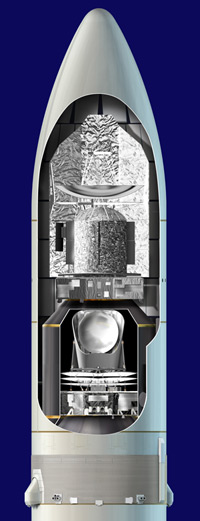This article is more than 1 year old
Herschel and Planck off to meet Lagrange
European twin 'scope launch tomorrow
The European Space Agency's Herschel and Planck space telescopes look good to go tomorrow (Thursday 14 May) at 13:12 GMT from the ESA spaceport in French Guiana.
 Sitting atop an Ariane 5 ECA (see graphic), the two vehicles are ultimately destined for "L2", the second Lagrangian point lying around 1.5m km from Earth "where all the gravitational forces acting between two objects cancel each other out and therefore can be used by spacecraft to 'hover'".
Sitting atop an Ariane 5 ECA (see graphic), the two vehicles are ultimately destined for "L2", the second Lagrangian point lying around 1.5m km from Earth "where all the gravitational forces acting between two objects cancel each other out and therefore can be used by spacecraft to 'hover'".
Once "hovering", Herschel will get down to the business of probing the cosmos with its infrared telescope capable of covering the entire spectrum from far-infrared to sub-millimetre wavelengths.
Planck, meanwhile, will be set to studying the Cosmic Microwave Background "with the highest accuracy ever achieved".
That's the plan, but there's the small matter of first getting the two spacecraft onto the right trajectory using a single lifter. Once off the launchpad, the Ariane 5 ditches its solid boosters after around two-and-a-half minutes. Upper stage separation and engine ignition are scheduled for around nine minutes, after which the upper stage accelerates to towards the 10 km/s at which it will offload its cargo.
First to go will be Herschel (seen in the pic nestled at the top of the upper stage), departing at around 26 minutes after launch. One-and-a-half minutes later, the support structure which supported Herschel and protected Planck will be jettisoned and the latter will follow shortly after, at just under 29 minutes into the mission.
ESA continues: "The launcher will set the satellites directly on the path to L2. This means that no injection manoeuvre will be necessary for Herschel; the satellite will be close to its orbit around L2 right from separation. One major manoeuvre is planned to fine-tune the orbit about 24 hours after launch.
"Planck will also be in orbit around L2 at separation, but since the amplitude of its orbit is half that of Herschel, engineers will execute manoeuvres to reduce its orbit to half that of the original. The first manoeuvre is planned about 30 hours after launch."
Ultimately, and assuming all goes according to plan, Herschel's final "quasi-halo orbit" will see it at an average distance of 800,000 km from L2. Planck will settle into a Lissajous orbit "with an amplitude of 400,000 km".
For those of you who've never adopted a Lissajous or quasi-halo orbit, the former is "the natural motion of a satellite around a collinear libration point in a two-body system" (more here). The latter, ESA helpfully explains, is "an orbit that resembles a halo orbit"*, but it's actually a variant of the Lissajous orbit. ®
Bootnote
*"Where the satellite follows a simple circular or elliptical path about the libration point."
